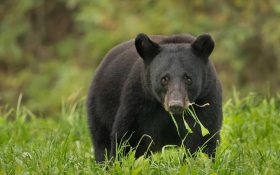
American Black Bear
Ursus americanus Oscar is our American Black Bear on exhibit! Check him out in the back of the Louisiana Purchase exhibit!
Animal Behavior: Black bears are generally crepuscular, although breeding and feeding activities may alter this pattern seasonally. Where human food or garbage is available, individuals may become distinctly diurnal (on roadsides) or nocturnal (in campgrounds). Nuisance activities are usually associated with sources of artificial food and the very opportunistic feeding behaviors of black bears. During periods of inactivity, black bears utilize bed sites in forest. Black bears are normally solitary animals except for female groups (adult female and cubs), breeding pairs in summer, and congregations at feeding sites. In areas where food sources are aggregated, large numbers of bears congregate and form social hierarchies, including non-related animals of the same sex that travel and play together.
Eating Habits: Throughout their range in North America, black bears consume primarily grasses. Only a small portion of the diet of bears consists of animal matter, and even then primarily in the form of colonial insects and beetles. Black bears are not active predators and feed on vertebrates only if the opportunity exists.
Range: Throughout their range, prime black bear habitats are characterized by relatively inaccessible terrain, thick understory vegetation, and abundant sources of food in the form of shrub or tree-borne soft or hard mast. In the southwest, prime black bear habitat is restricted to vegetated, mountainous areas ranging from 900 to 3,000 m in elevation. Bears occasionally move out of the chaparral into more open sites and feed on prickly pear cactus. Black bears in the southern Appalachian Mountains survive in a predominantly oak- hickory and mixed mesophotic forest. In the coastal areas of the southeast, bears inhabit a mixture of flatwoods, bays, and swampy hardwood sites. In the northeast, prime habitats consist of a forest canopy of hardwoods such as beech, maple, and birch, and coniferous species.
Conservation Efforts: Black bears once lived throughout most of North America but hunting and agriculture drove them into heavily forested areas. Residual populations survive over much of the range in sparsely populated wooded regions and under protection in national parks. They are numerous and thriving but continue to face threats regionally due to habitat destruction and hunting.
Animal Facts: Black bears are usually black in color, particularly in eastern North America. They usually have a pale muzzle which contrasts with their darker fur and may sometimes have a white chest spot. Western populations are usually lighter in color, being more often brown, cinnamon, or blonde. Some populations in coastal British Columbia and Alaska are creamy white or bluish gray. Total body length in males ranges from 1400 to 2000 mm, and from 1200 to 1600 mm in females. Tail length ranges from 80 to 140 mm. Males weigh between 47 and 409 kg, females weigh between 39 and 236 kg. Black bears are distinguished from grizzly or brown bears (Ursus arctos) by their longer, less heavily furred ears, smaller shoulder humps, and a convex, rather than concave, profile.
